
- •Contents
- •1. Fundamentals of Pathology
- •4. Tissue Repair
- •5. Circulatory Pathology
- •8. Amyloidosis
- •13. Vascular Pathology
- •16. Renal Pathology
- •17. Gastrointestinal Tract Pathology
- •18. Pancreatic Pathology
- •21. Central Nervous System Pathology
- •23. Female Genital Pathology
- •24. Breast Pathology
- •25. Male Pathology
- •26. Endocrine Pathology
- •27. Bone Pathology
- •28. Joint Pathology
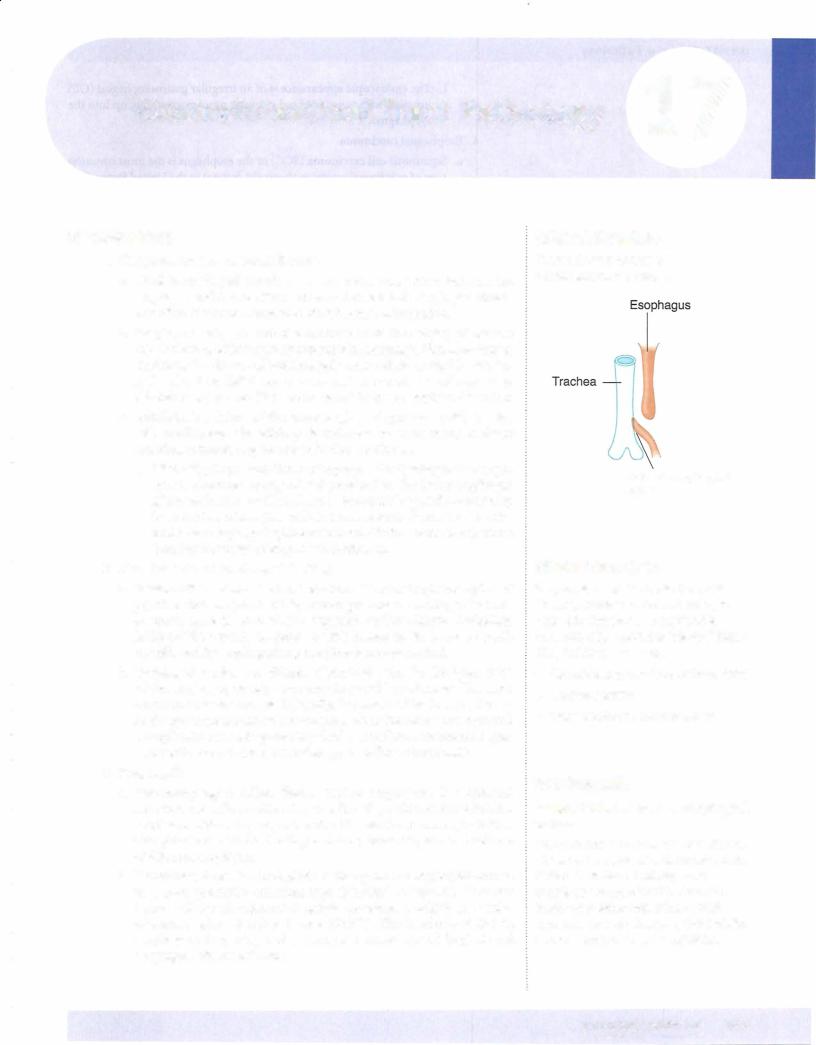
Gastrointestinal Tract Pathology 1 7
ESOPHAGUS
1. Congenital and mechanical disorders
a.Tracheoesophageal fistula is a congenital connection between the esophagus and trachea that is often associated with esophageal atresia. It is often discovered soon after birth because of aspiration.
b.Esophageal webs are web-like protrusions of the esophageal mucosa into the lumen which typically present with dysphagia. Plummer-Vinson syndrome is a disease of middle-aged women characterized by esopha geal webs, iron deficiency anemia, and increased risk of carcinoma. Schatzki rings are web-like narrowings at the gastroesophageal junction.
c.Achalasia is a failure of the lower esophageal sphincter (LES) to relax with swallowing. The etiology is unknown in most cases; in South America, achalasia may be caused by Chagas disease.
i.Clinically,the presentation is withprogressive dysphagia. The esoph agus is characteristically dilated proximal to the lower esophageal sphincter; barium swallowshows a "bird-beak" sign. Microscopically, there is a loss of ganglion cells in the myenteric plexus. Treatment is with lower esophageal sphincter balloon dilation or myotomy. There is an increased risk of esophageal carcinoma.
2.Hematemesis and esophageal bleeding
a.Mallory-Weiss syndrome has linear lacerations at the gastroesophageal junction that are produced by severe prolonged vomiting; the most common cause is acute alcohol ingestion and/or chronic alcoholism. Mallory-Weiss syndrome presents with hematemesis; it can be rarely complicated by esophageal rupture (Boerhaave syndrome).
b.Esophageal varices are dilated submucosal veins in the lower third of the esophagus, usually secondary to portal hypertension. The most common cause is cirrhosis. Clinically, the presentation is asymptomat ic, though there is massive hematemesis when the varices are ruptured. Complications include potentially fatal hemorrhage. Treatment is gen erally with band ligation, sclerotherapy, or balloon tamponade.
3.Esophagitis
a. Gastroesophageal reflux disease (reflux esophagitis) is esophageal irritation and inflammation due to reflux of gastric secretions into the esophagus. Reflux typically presents with heartburn and regurgitation. Complications include bleeding; stricture; bronchospasm and asthma; and Barrett esophagus.
b.Barrettesophagus is a metaplasia of the squamous esophageal mucosa to a more protective columnar type (intestinal metaplasia). It occurs because of chronic exposure to gastric secretions, usually in the setting of gastroesophageal reflux disease (GERD). The incidence of Barrett esophagus is increasing, and there is an increased risk of dysplasia and esophageal adenocarcinoma.
Clinical Correlate
The most common type of tracheoesophageal fistula:
Tracheoesophageal fistula
Clinical Correlate
Chagas disease: This tropical parasitic disease, common in South America, is caused by Trypanosoma cruzi and is transmitted by reduviid or "kissing" bugs. Chagas disease can cause:
•Romaiia's sign (swelling ofthe eyelids)
•Cardiomyopathy
•Megaesophagus and megacolon
In a Nutshell
Mallory-Weiss tears vs. esophageal varices:
Although both are associated with alcohol abuse and can presentwith hematemesis, Mallory-Weiss tears typically occur acutely as a result of retching/vomiting. Esophagealvarices result from portal hypertension and will usually present with a more significant bleeding episode.
MEDICAL 163

USMLE Step 1 • Pathology
Clinical Correlate
Pyloric stenosis is congenital hypertrophy ofthe pyloris, which presents with projectile vomiting and a palpable abdominal "olive."
i . The endoscopicappearance is ofan irregular gastroesophageal (GE) junction with tongues ofred granular mucosa extending up into the esophagus.
4.Esophageal carcinoma
a.Squamous cell carcinoma (SCC) ofthe esophagus is the most common type ofesophageal cancer in theworld, but not in the United States. SCC affects males more than females, and African Americans more than Caucasians; the typical age is usually older than 50 years.
i.Riskfactors are numerous, and include heavy smoking and alcohol use, achalasia, PlUillffier-Vinson syndrome, tylosis, and prior lye ingestion.
ii.The presentation varies. SCC of the esophagus is often asymptom atic until late in the course. When symptoms do develop, they may include progressive dysphagia; weight loss and anorexia; bleeding; or hoarseness or cough (advanced cancers).
m.Diagnosis is by endoscopy with biopsy; treatment is with surgery, with the prognosis being poor.
b.Adenocarcinoma of the esophagus is more common than SCC in the United States, and affects Caucasians more than African Americans. Adenocarcinoma arises in the distal esophagus; is associated with Barrett esophagus and dysplasia. The prognosis is poor.
STOMACH
1.Congenital disorders
a.Pyloric stenosis is a congenital stenosis of the pylorus due to marked muscular hypertrophy ofthe pyloric sphincter, resulting in gastric out let obstruction. It affects male infants more than females. It is associated with Turner and Edwards syndromes.
i.The presentation is with the onset of regurgitation and vomiting in the second weekoflife; waves ofperistalsis arevisible onthe abdomen and there is a palpable oval abdominal mass. Treatment is surgical.
b.Congenital diaphragmatic hernia occurs when a congenital defect is present in the diaphragm, resulting in herniation of the abdominal organs into the thoracic cavity. The stomach is the most commonly herniated organ due to left-sided congenital diaphragmatic hernia. Congenital diaphragmatic hernia is often associated with intestinal malrotation. It may be complicated by significant lung hypoplasia.
164 MEDICAL

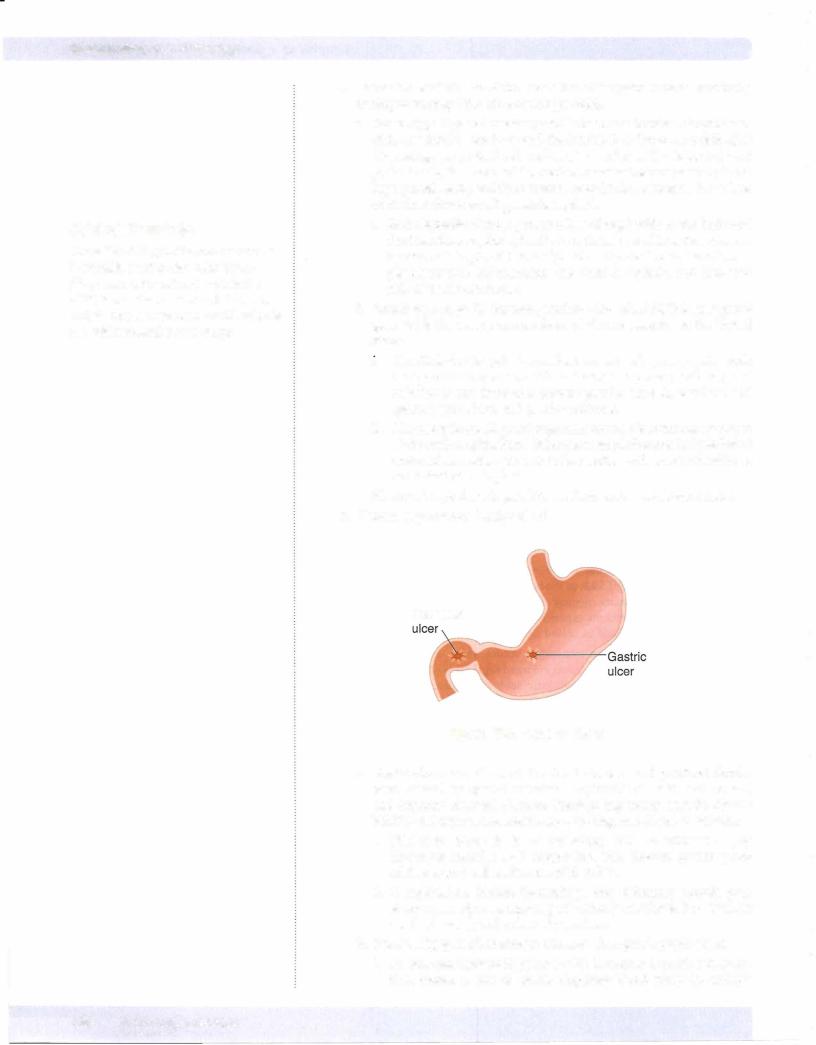
USMLE Step 1 • Pathology
Clinical Correlate
The ability ofH. pylorito produce urease is clinically used for detection by the [13C]-urea breath test and clofazimine (CLO) tests. Other methods ofdetection include biopsy (histologic identification is the gold standard) and serology.
166 MEDICAL
4. Chronicgastritisis chronic inflammation ofthe gastric mucosa eventually leading to atrophy (chronic atrophic gastritis).
a. Fundic type (typeA) chronic gastritis is an autoimmune atrophic gas tritis that involves the body and the fundus. It is due to autoantibodies directed againstparietal cellsand/or intrinsic factor. This leads to loss of parietal cells, decreased acid secretion, increased serum gastrin (G-cell hyperplasia), and pernicious anemia (megaloblastic anemia due to lack of intrinsic factor and B12 malabsorption).
i. Pathologically, there is grossly a loss ofrugal folds in the body and fundus. Microscopically, fundic type chronic gastritis is characterized by mucosa! atrophywith loss ofglands and parietal cells, chroniclym phoplasmacytic inflammation, intestinal metaplasia, and increased risk ofgastric carcinoma.
b. Antral type (type B) chronic gastritis (also called Helicobacter pylori gastritis) is the most common form of chronic gastritis in the United States.
i. |
The Helicobacterpylori organisms are curved, gram-negative rods |
|
that produce urease. The risk of infection increases with age, and |
|
infection is associated with chronic gastritis (type B), duodenal and |
|
gastric peptic ulcers, and gastric carcinoma. |
IL Microscopically, H. pylori organisms are visible in the mucous layer ofthe surface epithelium. Other microscopic features include foci of acute inflammation, chronic inflammation with lymphoid follicles, and intestinal metaplasia.
iii.Antral-type chronic gastritits predisposes for gastriccarcinoma.
5.Chronicpepticulcer (benign ulcer)
Duodenal
Figure 17-2. Types of ulcers
a. Peptic ulcers are ulcers of the distal stomach and proximal duode num caused by gastric secretions (hydrochloric acid and pepsin) and impaired mucosal defenses. Predisposing factors include chronic NSAID and aspirin use, steroid use, smoking, and H. pylori infection.
i. Clinically, diagnosis is by endoscopy with or without biopsy. Treatment includes acid suppression (H2 blocker, proton pump inhibitor, etc.) and eradication ofH. pylori.
ii. Complications include hemorrhage, iron deficiency anemia, pen etration into adjacent organs, perforation (x-rayshows free air under the diaphragm), and pyloric obstruction.
b.Duodenal pepticulceris more common than gastric peptic ulcer.
I. Associations include H. pylori ( 100%); increased gastric acid secre
tion; increased rate of gastric emptying; blood group O; multiple

Chapter i.7 • Gastrointestinal Tract Pathology
endocrine neoplasia (MEN) type I and Zollinger-Ellison syndromes; cirrhosis; and chronic obstructive pulmonary disease.
u. Clinically,most duodenal peptic ulcers are located inthe anterior wall of the proximal duodenum. The classic presentation is with burning epigastric pain 1 to 3 hours after eating, which is relieved by food.
c. Gastric peptic ulcer is associated with H. pylori (75%). The ulcers are typically located in the lesser curvature of the antrum. Grossly, these are small (<3 cm), sharply demarcated ('punched out'), solitary ulcers with round or oval shape, overhanging margins, and radiating mucosal folds. The classic presentation is with burning epigastric pain, which worsens with eating.
6. Gastric carcinoma (malignant ulcer)
a. Epidemiology. Gastric carcinoma is more common in Japan than in the United States, and has a decreasing incidence in the United States.
i.Dietaryfactors can be riskfactors,and include smoked fish and meats,
pickled vegetables, nitrosamines, benzpyrene, and decreased intake of fruits and vegetables. Other risk factors include H. pylori infection, chronicatrophicgastritis, smoking, blood type A, bacterial overgrowth in the stomach, prior subtotal gastrectomy, and Menetrier disease.
u.Clinically, gastric carcinoma is often (90%) asymptomatic until late
in the course, when it can produce weight loss and anorexia. It can also present with epigastric abdominal pain mimicking a peptic ulcer, early satiety, and occult bleeding with iron deficiency anemia.
Gastric carcinoma is most commonly located in the lesser curvature ofthe antrum, and causes a large (>3 cm), irregular ulcer with heaped-up margins and a necrotic ulcer base. It may also occur as a flat or polypoid mass. Several histological types occur.
iv.The intestinalhistologictype microscopically shows gland-forming adenocarcinoma.
v.The diffuse type of gastric carcinoma shows diffuse infiltration of stomach by poorly differentiated tumor cells, frequently numer ous signet-ring cells (whose nuclei are displaced to the periphery by intracellular mucin), and linitis plastica (thickened "leather bottle"-like stomach) gross appearance.
vi.Gastric carcinomas may specifically metastasize to the left supra clavicular lymph node (Virchow sentinel node) and to the ovary (Krukenberg tumor).
vii.Diagnosis is by endoscopy with biopsy; treatment is with gastrec tomy. The prognosis is poor, with overall 5-year survival of 20%.
SMALL AND LARGE INTESTINES
1. Mechanical obstruction
a. Volvulus is a twisting of a segment of bowel on its vascular mesentery, resulting in intestinal obstruction and infarction. Volvulus is often associated with congenital abnormalities such as intestinal malrotation. Common locations include the sigmoid colon and small bowel; compli cations include infarction and peritonitis.
b. Intussusception is the telescoping of a proximal segment of the bowel into the distal segment. It is most common in infants and children. In adults, intussusception may be associated with a mass or tumor; it presents with intestinal obstruction, abdominal pain, and "currant-jelly" stools. The intussuscepted segment can become infarcted.
MEDICAL 167
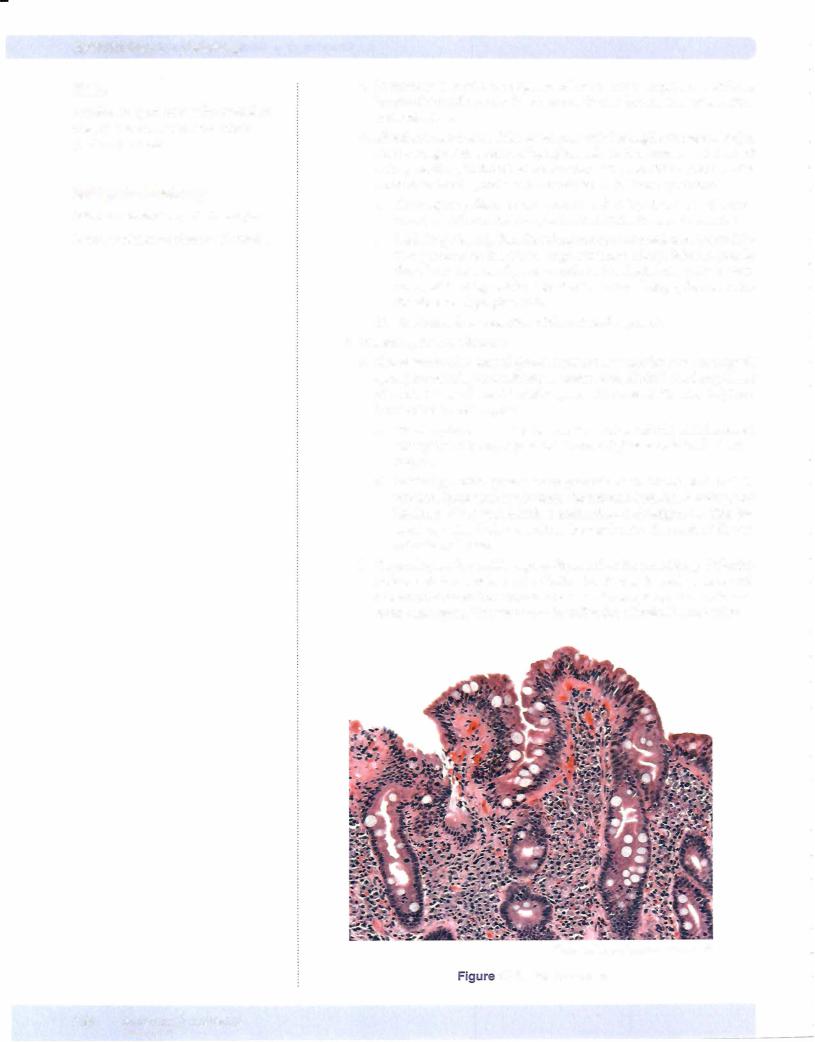
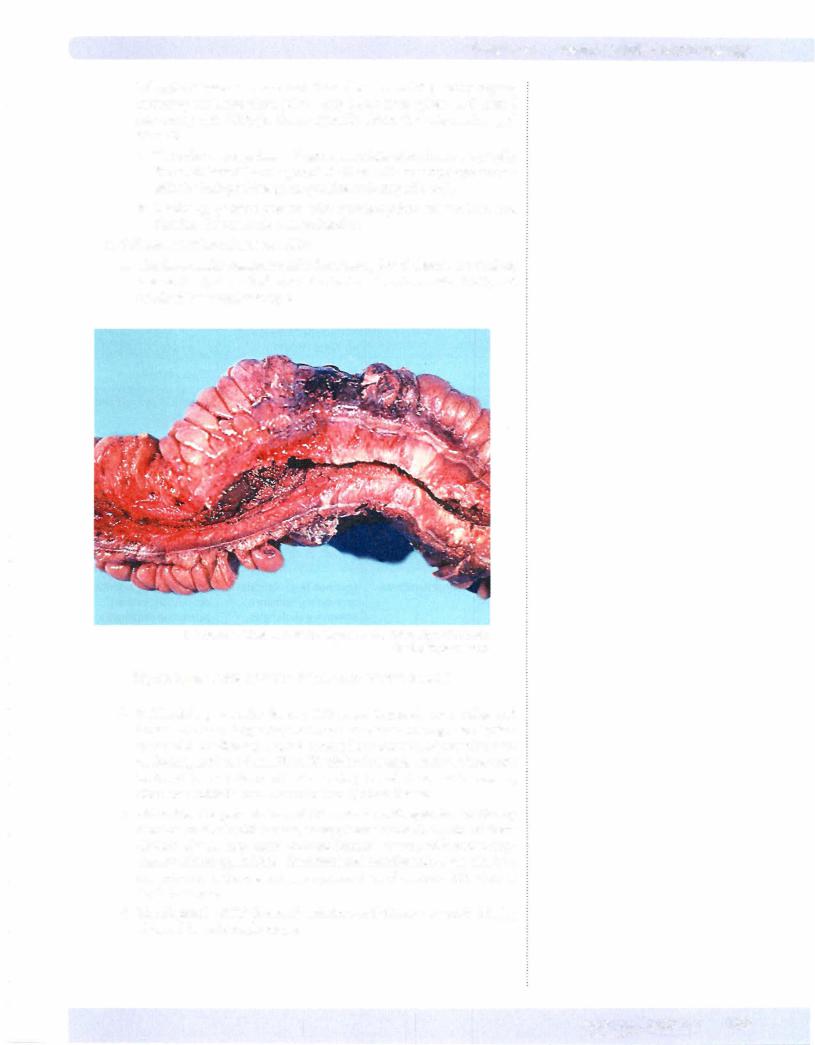
Chapter 17 • Gastrointestinal Tract Pathology
c.Whipple disease is a rare infectious disease involving many organs, including small intestines, joints, lung, heart, liver, spleen, and central nervous system. Whipple disease typicallyaffects Caucasian males aged
30 to 50.
i.The infecting organism is Tropheryma whipplei, andmicroscopically, the small bowel lamina propria is filled with macrophages stuffed with the PAS-positive, gram-positive, rod-shaped bacilli.
ii.Clinically, patients present with malabsorption, weight loss, and diarrhea. Treatment is with antibiotics.
3.Inflammatorybowel disease (IBD)
a.The three major categories of inflammatory bowel disease are Crohn's disease (CD), also called regional enteritis, ulcerative colitis (UC), and colitis ofindeterminate type.
© Katsumi M. Miyai, M.D., Ph.D.; Regents of the University of California. Used with permission.
Figure 17-4. Narrowed Colon Segment in Crohn's disease
b.Epidemiology. Females develop IBD more frequently than males, and Caucasians more frequently than non-Caucasians. The age distribution varies with the disease; Crohn's disease has a bimodal distributionwith peaks at ages 10 to 30 and 50 to 70, while ulcerative colitis peaks at ages 20 to 30. The incidence of inflammatory bowel disease is increasing; ulcerative colitis is more common than Crohn's disease.
c.Clinically, the presentation of IBD can be with episodes of bloody diarrhea or stools with mucus, crarnpy lower abdominal pain, or fever. Crohn's disease may cause perianal fistulas, present with malabsorp tion, or mimic appendicitis. Extraintestinal manifestations canalso be a presentation, and are seen more commonly in ulcerative colitis than in Crohn's disease.
d.The diagnosis ofIBD is one ofexclusion,withtissuetobestudiedbeing obtainedbyendoscopicbiopsy.
MEDICAL 169
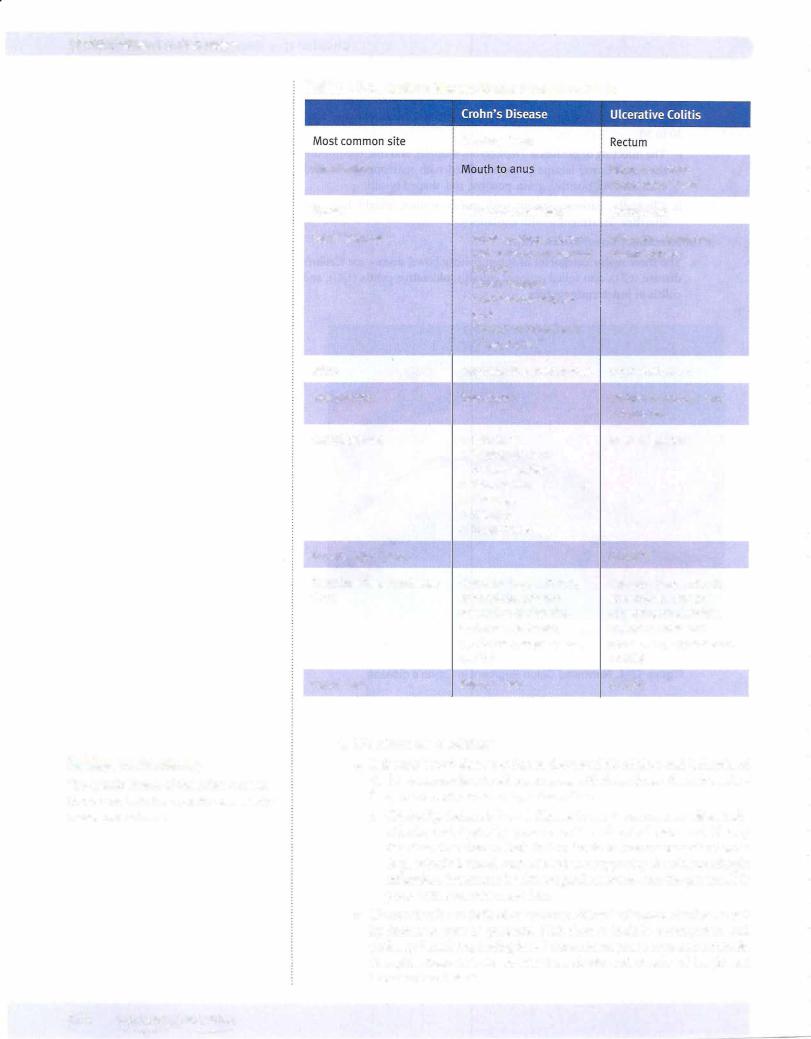

Chapter 17 • Gastrointestinal Tract Pathology
c.Angiodysplasia is defined as arteriovenous malformations of the intes tines; it occurs in the cecum and right colon. It is common in individu als over age 55, presenting with multiple episodes of rectal bleeding. Angiodysplasia is associated with Osler-Weber-Rendu and CREST syndromes. Treatment is surgical resection.
d.Melanosis coli is common with laxative abuse; it causes black pig mentation of the colon due to the ingestion of the laxative pigment by macrophages in the mucosal and submucosa. Melanosis coli can mimic colitis or malignancy.
e.Pseudomembranous colitis (antibiotic-associated colitis) is an acute colitis characterized by the formation of inflammatory pseudomem branes in the intestines. It is usually due to Clostridium difficile infection (often brought on by a course of broad-spectrum antibiotics, especially clindamycin and ampicillin), but pseudomembranous colitis can also be due to ischemic bowel disease.
i.Pathology. Gross examination shows yellow-tan mucosal mem branes. Microscopic examination shows superficial colonic necrosis with an overlying pseudomembranes; the pseudomembranes are mushroom-shaped inflammatoryexudates composed ofneutrophils, mucin, fibrin, and necrotic cellular debris.
ii.Clinically, the presentation is with diarrhea, fever, and abdominal cramps, and the diagnosis is established with detection of C. difficile toxin in the stool. Treatment of clostrial pseudomembranous colitis is with vancomycin or metronidazole.
f.Appendicitis is most commonly caused by obstruction of the appendix by a fecalith. Appendicitis often starts with periumbilical pain that subse quently localizes to the right lower quadrant. Nausea, vomiting, and fever may also be present. Laboratory studies show an elevated white blood cell count. A complication is appendiceal rupture leading to peritonitis.
i.Pathology. Grossly, a fibrinopurulent exudate may be seen on the appendiceal serosa; microscopically, neutrophils are present within the mucosa and muscular wall (muscularis propria) of the appendix.
5.Diverticula
a.Meckel diverticulum is a congenital small bowel diverticulum due to persistance of a remnant of the vitelline (omphalomesenteric) duct.
i.Ruleof2s:
•2% of the normal population
•2 feet from the ileocecal valve
•2 cm in length
•2 years old or younger at the time of diagnosis
•2% of carcinoid tumors occur in a Meckel diverticulum.
ii.Clinically, most Meckel diverticula are asymptomatic, but they may contain rests of ectopic gastric mucosa and present with intestinal bleeding.
b.Colonic diverticulosis refers to acquired outpouchings of the bowel wall, characterized by herniation of the mucosa and submucosa through the muscularis propria (pseudodiverticulum). Colonic diverticulosis is extremely common in the United States, and the incidence increases with age. The major risk factor is low-fiber diet, which leads to increased intra luminal pressure; the most common location is in the sigmoid colon.
i.Clinically, the presentation varies, with many cases being asympto matic and picked up on screening colonoscopy. When symptomatic,
In a Nutshell
Osler-Weber-Rendu Syndrome
•a.k.a. Hereditary hemorrhagic telangiectasia
•Autosomal dominant
•Telangiectasias of skin and mucous membranes
•Common on lips, tongue, and fingertips
•May develop iron deficiency anemia
Note
Given that onlytwo layers ofthe bowelwall are involved, these acquired outpouchings are technically pseudodiverticula.
MEDICAL 171
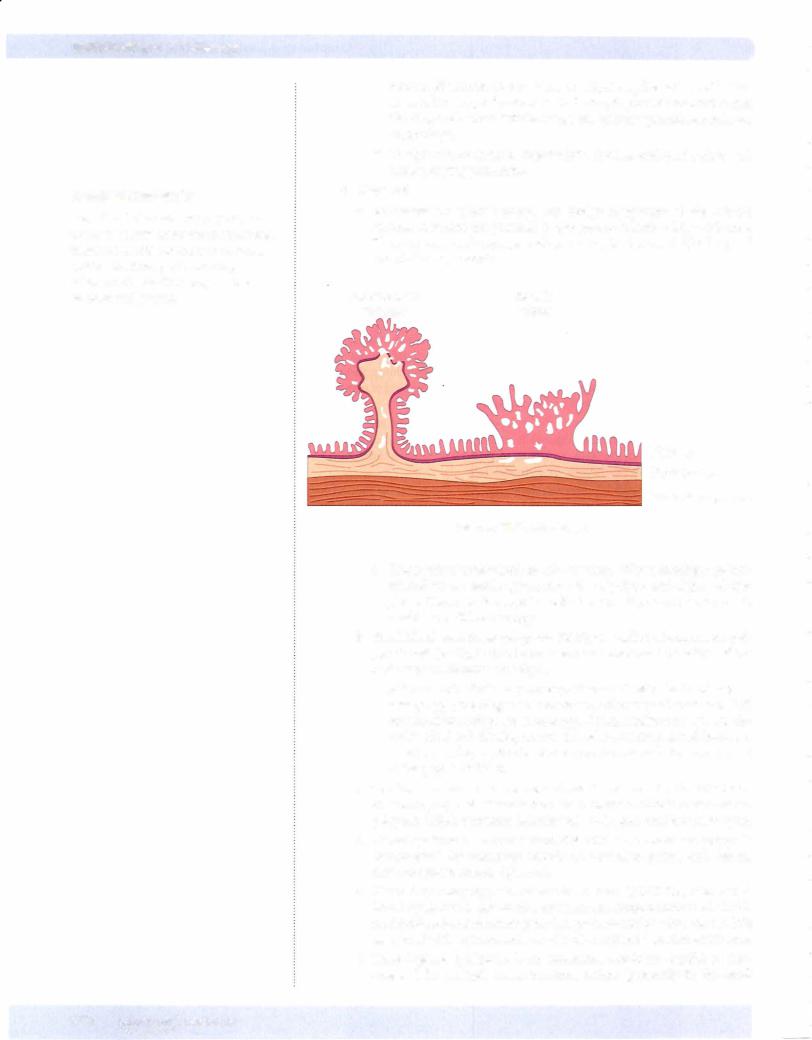
USMLE Step 1 • Pathology
Clinical Correlate
It is estimated to take roughly 10 years to progress from adenoma to carcinoma, which makes colonoscopy an effective tool for identifying and removing adenomas before they progress to an invasive malignancy.
colonic diverticulosis can cause constipation alternating with diar rhea, left lower quadrant abdominal cramping and discomfort, occult bleeding and an iron deficiency anemia, or lower gastrointestinal tract hemorrhage.
ii.Complications include diverticulitis, fistulas, and perforation with accompanying peritonitis.
6.Neoplasia
a.Adenomatous colonic polyps are benign neoplasms of the colonic mucosa that have the potential to progress to colonic adenocarcinoma. They are commonly asymptomatic, but may lead to occult bleeding and iron deficiency anemia.
Pedunculated |
Sessile |
Tubular |
Villous |
Mucosa
Submucosa
Muscularis propria
Figure 17-5. Adenomas
i.Prognostic features include tubular versus villoushistology, pedun culated versus sessile appearance, size of polyps, and degree of dys plasia. Diagnosis is suspected with hemoccult positive stools and is established with endoscopy.
b.Familial adenomatous polyposis (FAP), also called adenomatous pol yposis coli (APC), is due to an autosomal dominant mutation of the APC gene on chromosome Sq21.
i . Affected individuals may develop thousands of colonic adenoma
tous polyps; the diagnosis is made with discovery of more than 100 adenomatous polyps on endoscopy. Complications: by age 40, vir tually 100% willdevelop an invasive adenocarcinoma and increased risks for developing duodenal adenocarcinoma and adenocarcinoma of the papilla ofVater.
c.Gardner syndrome is an autosomal dominant variant of famial adeno matosous polyposis characterized by numerous colonic adenomatous polyps, multiple osteomas, fibromatosis, and epidermal inclusion cysts.
d.Turcotsyndrome is a rare variant of familial adenomatosous polyposis characterized by numerous colonic adenomatous polyps and central nervous system tumors (gliomas).
e.Hereditary nonpolyposis colorectal cancer (HNPCC), also called Lynch syndrome is due to an autosomal dominant mutation of a DNA nucleotide mismatch repair gene that predisposes for colon cancer. It is associated with an increased risk ofendometrial and ovarian carcinoma.
f.Peutz-Jeghers syndrome is an autosomal dominant condition char acterized by multiple hamartomatous polyps (primarily in the small
172 MEDICAL


USMLE Step 1 • Pathology
Note
Histologically, carcinoid tumors appear similarto other neuroendocrine tumors with nests of small uniform cells.
Bridge to Biochemistry
Serotonin is converted to
5-HIAA by monoamine oxidase.
h. Carcinoid tumors are neuroendocrine tumors that often produce sero tonin. Important locations for carcinoid tumors include the appendix (most common) and the terminal ileum. Metastasis to the liver may result in carcinoid heart disease.
i.Carcinoid syndrome is characterized by diarrhea, cutaneous flushing, bronchospasm and wheezing, and fibrosis. The diag nosis is substantiated by demonstrating elevated urinary 5-HIAA (5-hydroxyindoleacetic acid).
Chapter Summary
•Congenital and mechanical disorders of the esophagus include tracheoesophageal fistula (associated with esophageal atresia and aspiration), esophageal webs (associated with iron deficiency anemia and increased risk of cancer), and achalasia (associated with increased risk of cancer). Achalasia is due to failure ofthe lower esophageal sphincter to relaxwith swallowing.
•Esophageal bleeding can be due to laceration at the gastroesophageal junction produced by severe vomiting (Mallory-Weiss syndrome), or esophageal varices that develop secondary to portal hypertension.
•Gastroesophageal reflux disease is esophageal irritation and inflammation due to reflux of gastric secretions into the esophagus. Barrett esophagus is metaplasia ofthe squamous esophageal mucosa to a more protective columnar type because of chronic exposure to gastric secretions.
•Esophageal carcinoma may be either squamous cell carcinoma or adenocarcinoma. Squamous cell carcinoma is the most common form in the world and is associated with heavy smoking, heavy alcohol use, achalasia, and Plummer-Vinson syndrome. Adenocarcinoma involves the distal esophagus and usually arises in areas of Barrett esophagus.
•Pyloric stenosis is a congenital stenosis ofthe pylorus due to marked muscular hypertrophy ofthe pyloric sphincter, resulting in gastric outlet obstruction. Congenital diaphragmatic hernia is a congenital defect in the diaphragm, resulting in herniation ofthe abdominal organs into the thoracic cavity.
•Menetrier disease is a form of hypertrophic gastropathy with enlarged rugal folds that can produce decreased acid production, a protein-losing enteropathy, and increased riskof cancer. Zollinger-Ellison syndrome is a form of hypertrophic gastropathy with enlarged rugal folds that occurs secondaryto gastrin stimulation by a pancreatic gastrinoma.
•Acute hemorrhagic gastritis is acute inflammation, erosion, and hemorrhage of the gastric mucosa due to a breakdown ofthe mucosaI barrier and acid-induced injury. Gastric stress ulcers are multiple, small, round, superficial ulcers of the stomach and duodenum.
•Chronic gastritis is a chronic inflammation ofthe gastric mucosa resulting in eventual atrophy. Chronic gastritis is subdivided into a fundic type, which is
related to autoantibodies to parietal cells and/or intrinsic factor, and an antral type, which is related to He/icobacterpylori gastritis.
•Peptic ulcers are ulcers ofthe distal stomach and proximal duodenum caused by gastric secretions (hydrochloric acid and pepsin) and impaired mucosa! defenses. Duodenal peptic ulcers are more common than gastric ulcers.
•Gastric carcinomas tend to be asymptomatic until late in their course and may show a variety of histologic patterns.
(Continued)
1 74 MEDICAL

Chapter 17 • Gastrointestinal Tract Pathology
Chapter Summary (cont,d)
•Volvulus is twisting of a segment of bowel on its vascular mesentery, resulting in intestinal obstruction and infarction. lntussusception is telescoping of a proximal segment of bowel into the distal segment. Incarcerated hernia is a segment
ofbowel that becomes imprisoned within a hernia. Hirschsprung disease is a congenital absence ofganglion cells in the rectum and sigmoid colon resulting in intestinal obstruction.
•Celiac sprue is a hypersensitivityto gluten, resulting in loss of small bowel villi and malabsorption. Tropical sprue is a malabsorptive disease of unknown etiology affecting travelers to tropical regions, such as the Caribbean and South America. Whipple disease is a rare infectious disease involving many organs, including small intestines, joints, lung, heart, liver, spleen, and CNS.
•Inflammatory bowel disease includes Crohn disease, ulcerative colitis, and colitis of indeterminate type. Crohn disease has "skip" lesions, has transmural involvement with formation ofgranulomas, and tends to form fistulas, abscesses, and sinuses. In contrast, ulcerative colitis is confined to the rectum and colon, has inflammation limited to the mucosa and submucosa with crypt abscess, is
more likelyto have extraintestinal manifestations, and can cause toxic megacolon.
•lschemic bowel disease is the result of decreased blood flow and ischemia ofthe bowel secondary to atherosclerosis with thrombosis, thromboembolism, or reduced cardiac output from shock. Hemorrhoids are tortuous dilated submucosal veins caused by increased venous pressure. Angiodysplasia is arteriovenous malformation ofthe intestines. Melanosis
coli is a black pigmentation ofthe colon that is common with laxative abuse. Pseudomembranous colitis is characterized by formation of inflammatory pseudomembranes in the intestine following infection by Clostridium difficile, and/or ischemic bowel disease.
•Meckel diverticulum is a congenital small bowel diverticulum that is a remnant ofthe vitelline duct. Colonic diverticulosis is a common condition among
the elderly population and features acquired outpouchings ofthe bowel wall, characterized by herniation of the mucosa and submucosa through the muscularis propria.
•Adenomatous colonic polyps are benign neoplasms ofthe colonic mucosa that have the potential to progress to colonic adenocarcinoma. Familial adenomatous polyposis is a genetic condition in which patients develop thousands of colonic adenomatous polyps and have a virtually 100% chance ofdeveloping colon cancer by age 40 unless the affected colon is resected. Gardner syndrome
is a variant offamilial adenomatous polyposis with associated osteomas, fibromatosis, and epidermal inclusion cysts. Turcot syndrome is a rare variant offamilial adenomatous polyposis associated with CNS gliomas. Hereditary nonpolyposis colorectal cancer has increased risks of colon, endometrial, and ovarian cancers, but it is not associated with multiple adenomatous polyps.
Peutz-Jeghers syndrome has multiple hamartomatous polyps with increased risk of cancers ofthe lung, pancreas, breast, and uterus, but not colon.
•Colonic adenocarcinoma is the third most common cancer and a leading cause of cancer mortality in the United States. It tends to produce a polypoid mass when it involves the right side ofthe colon and a napkin ring lesion when it involves the left side. The Dukes system is used forstaging colon cancer.
•Carcinoid tumors are neuroendocrine tumors that can involve the appendix and terminal ileum and may produce carcinoid syndrome with diarrhea, flushing, bronchospasms, fibrosis, and sometimes carcinoid heart disease.
MEDICAL 175

